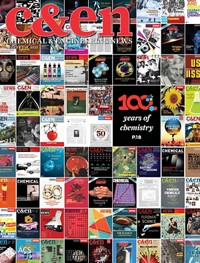Advertisement
Grab your lab coat. Let's get started
Welcome!
Welcome!
Create an account below to get 6 C&EN articles per month, receive newsletters and more - all free.
It seems this is your first time logging in online. Please enter the following information to continue.
As an ACS member you automatically get access to this site. All we need is few more details to create your reading experience.
Not you? Sign in with a different account.
Not you? Sign in with a different account.
ERROR 1
ERROR 1
ERROR 2
ERROR 2
ERROR 2
ERROR 2
ERROR 2
Password and Confirm password must match.
If you have an ACS member number, please enter it here so we can link this account to your membership. (optional)
ERROR 2
ACS values your privacy. By submitting your information, you are gaining access to C&EN and subscribing to our weekly newsletter. We use the information you provide to make your reading experience better, and we will never sell your data to third party members.
Education
Teamwork @ C&EN
by A. Maureen Rouhi
October 1, 2012
| A version of this story appeared in
Volume 90, Issue 40
Observant readers may have noticed a line missing on the masthead, that of deputy editor-in-chief. We are recruiting for this critical position, and we hope to fill it soon. In the meantime, the meticulous work of preparing and delivering stories for print or digital publication continues.
After reporters have completed their reporting and writing, their stories go through many levels of editing—by the assistant managing editor, the “top editor,” the production editor, and the copy editor—and checking of galleys, pages, and corrected pages. Too many levels, some writers complain. But as Managing Editor Robin Giroux writes in a memo, “The tiers are an important part of what makes our editorial content so strong.”
Giroux addressed the memo to staff who had volunteered to “top edit” the stories in this issue. At C&EN, the regular top editors are the editor-in-chief, the deputy editor-in-chief, and the managing editor; the assistant managing editors are often tapped if those ranks are thin. Because of the size of this week’s issue and the vacant position, Giroux sought help from staff, some of whom had not had the experience of top editing before. Giroux’ memo explains their role and the mechanics of the process.
“The top editor is the readers’ advocate,” Giroux writes. “The top editor is noticing where the progression or narrative doesn’t quite hold together. … Where the top editor pauses and thinks, ‘huh?’ the reader may be lost. We don’t want any (okay, many) lost readers. So it’s the top editor’s role to consider the reason for those pauses and address them,” she continues.
“Use your judgment in deciding when to make changes, suggest changes, and ask for information. … The ‘treat others as you want to be treated’ tenet works in top editing, too,” Giroux advises.
With or without the full coterie of people shepherding stories to the printer or online, every C&EN story goes through the rigorous quality control we have in place to ensure that what you, dear readers, read is the most accessible, engaging, and journalistically sound story we can muster in the short time we have to go from draft to published page.
Teamwork ensured the quality control this week, with the generous assistance of seven guest top editors: Assistant Managing Editors Sophie Rovner and Amanda Yarnell; Deputy Assistant Managing Editor Stu Borman; Senior Correspondent Cheryl Hogue; and Senior Editors Melody Bomgardner, Lila Guterman, and Glenn Hess.
Because of the commitment of these staffers to C&EN’s excellence, you can be sure that the stories in this issue hew to the high standards you expect. And so will those in future issues produced while we still lack one person to fulfill the key role of readers’ advocate, because other dedicated C&EN staff will step forward to do the important work.
Other members of the C&EN team then deliver the content to C&EN’s multiple distribution channels: to the printer for the hard-copy issue; to the technology partner for the electronic issue; and to the Web staff for C&EN Online, C&EN Mobile, and C&EN SCENEs.
Whether you’re reading this issue in print, on your computer, or with your mobile device, be sure to peruse this week’s pharma-focused features: Senior Correspondent Ann Thayer’s cover story on the growing trend of drug repurposing, or finding new therapeutic uses for approved drugs or failed clinical candidates; Senior Editor Lisa Jarvis’ look at Pfizer’s new partnerships with academic groups; and Senior Editor Rick Mullin’s status check on the fortunes of facilities formerly part of big pharma that are now owned by manufacturers of pharmaceutical chemicals.
Read about the frustrations wrought by the search for a permanent nuclear waste repository, by Senior Correspondent Jeff Johnson. Be riveted by Senior Editor Bethany Halford’s account of a synthetic method that literally pulls bonds apart.
Whatever feature catches your fancy was brought to you by Team C&EN.
Views expressed on this page are those of the author and not necessarily those of ACS.



Join the conversation
Contact the reporter
Submit a Letter to the Editor for publication
Engage with us on Twitter